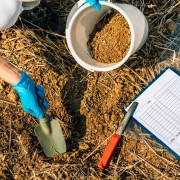How to Test Your Garden Soil (10-24-2022)
Soil testing gives you a snapshot of the health and fertility of your garden soil. It takes the guesswork out of how much fertilizer and water to use. It also tells you if you have a deficiency in a micro or macro nutrient, and how alkaline or acidic your soil is. The test results will help you amend your soil for better plant growth.
You can bring soil samples to the Dec 1, 2022 Horticulture Committee meeting at Ellen Gould’s home and Nan and Sherry will hand deliver your sample(s) to the CT Agricultural Experimental Station (CAES) in New Haven. There is no cost, and you will receive results by mail.
Here are the steps to get a good soil sample:
- Dig several thin slices of soil with a shovel or trowel in the area you want to be tested (4-6” deep in the garden and 3-5” deep in lawns). Combine the slices in a bucket and mix thoroughly.
- Do not combine samples from different areas if soil, fertilizer treatments or lime additions are different. Sample each area separately.
- Place 2 cups of mixed soil in a ziplock bag. If the soil is wet, let it dry before sealing the bag.
- Seal the bag and apply a label to the outside with the following information:
- Your name and mailing address
- The plants you are growing, or want to grow in the sampled area.
- Any plant problems that have occurred.
- State if you would like organic care instructions.
Questions? For more information on how to test your soil, read the CAES Soil Testing Brochure HERE.
Bulbs for Bees, September, 2022
It’s that time of year! The fall garden catalogs are filling your mailbox with tempting new bulbs, shrubs and perennials to brighten your gardens in the coming year.
This year, why not consider some of the earliest native bulbs? Called “spring ephemerals,” these bulbs, corms, rhizomes and tubers bloom in the early spring just as bees are emerging from hibernation, and then they go dormant. Like all native plants, they have co-evolved over thousands of years with the local pollinators that depend on them.
The following bulbs can be hard to find, but worth it! Included is a link to Prairie Moon Nursery, a reliable mail-order nursery that regularly stocks these natives.
- White Trout Lily (Erythronium americanum) – One of the earliest spring bloomers with trout-shaped, speckled leaves and tiny, yellow flowers on 4-6” stems. Grow with Virginia Bluebells and Spring Beauty. Available as a bare root plant from Prairie Moon Nursery in the spring. Click HERE to view.
- Spring Beauty (Claytonia virginica) – Another early bloomer, this corm has a tiny edible, potato-like corm and pink-veined, white flowers. It grows to just 6” tall in sun to filtered Grow with Bishop’s Cap or Toad Trillium. Available as a bare root plant in the summer and the fall. Click HERE to view.
- Bloodroot (Sanguinaria canadensis) – This rhizome thrives under the leaf litter of deciduous trees. It has multi-petaled, white flowers with bright yellow stamens in April/May. Grow with Foamflower, Nodding Trillium and Black Bugbane. Available as a bare root plant in the summer. Click HERE to view.
- Dutchman’s Breeches (Dicentra cucullaria) – This creamy-white, early bloomer has fragrant flowers shaped like pantaloons. It grows to 10” in mounds in filtered to part shade. Grow with Wild Ginger and Christmas Fern. Available as a bare root plant in the summer and fall. Click HERE to view.
- Dwarf Crested Iris (Iris cristata) – This fast-spreading rhizome has masses of pale to deep violet flowers on 4-6” stems with swordlike leaves. It blooms in mid-spring in shade to part-shade. Grow with Wild Geranium and Yellow Trillium. Available as a bare root plant in the spring and fall. Click HERE to view.
- Virginia Bluebells (Mertensia virginica) – This native grows along creeks and stream banks in rich, moist soil. It will grow in sun to filtered shade to a height of one to two feet. Pairs well with Woodland Phlox. Available as a bare root plant in the spring, summer and fall, and in potted trays of 32 plants in spring. Click HERE to view.
- Mayapple (Podophyllum peltatum) – Two 6-8” wide umbrella-like leaves have solitary, nodding flowers in late May. It grows on 12” stems in filtered shade, part shade or shade, and can be an aggressive spreader. Grow with ferns for textural contrast. Available as a bare root plant in the spring and fall. Click HERE to view.




